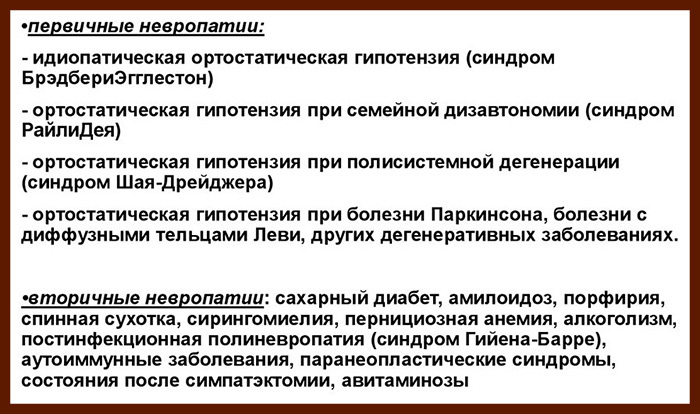Group cardiovascular pathologies includes a large number of diseases. The list includes stroke, heart attack and others. There are various reasons leading to pathologies of the heart and blood vessels. For example, unhealthy diet, stress, abuse of bad habits. Pathologies of the cardiovascular system are the leading cause of death worldwide.
Record content:
- 1 What is cardiovascular disease?
-
2 Causes of pathologies
- 2.1 Viruses and infections
- 2.2 Hypodynamia
- 2.3 Improper nutrition
- 2.4 Alcohol abuse
- 2.5 Malicious smoking
- 3 The main symptoms
-
4 List of cardiovascular diseases. Typical symptoms, principles of treatment
- 4.1 Ischemia
- 4.2 Hypertension
- 4.3 Rheumatic heart disease
- 4.4 Cardiomyopathy
- 4.5 Arrhythmia
- 4.6 Atherosclerosis
- 4.7 Cardiosclerosis
- 4.8 Myocardial infarction
- 4.9 Stroke
- 4.10 Pulmonary embolism
- 4.11 Heart failure
- 4.12 Heart disease
- 4.13 Infective endocarditis
- 5 Diagnostic methods
- 6 What can be done for the health of the heart and blood vessels?
- 7 Video about cardiovascular diseases
What is cardiovascular disease?
Cardiovascular diseases (the list of the most common pathologies is headed by a heart attack) is a group that affects the violation of the functionality of the heart and blood vessels. The abbreviated name is CVD.
Diseases can be congenital or acquired. In the first case, the pathology is transmitted when the fetus is in the womb. Acquired CVDs develop as a result of exposure to risk factors (stress, unhealthy diet, etc.).
Any disease of the cardiovascular system requires timely diagnosis and treatment. If this item is neglected, there is a high probability of complications and death.
Causes of pathologies
Diseases of the cardiovascular system (CVS) can appear for various reasons.
The most common ones are:
- viral and infectious disease;
- sedentary lifestyle;
- improper nutrition;
- frequent use of alcoholic beverages;
- smoking abuse.
Other factors leading to CVD diseases:
- spine pathology - the organ contains many nerve endings that can be damaged, as a result, diseases of the cardiovascular system develop;
-
overweight - the item contributes to the disruption of metabolic processes, the heart needs to work hard to supply the entire body with oxygen;
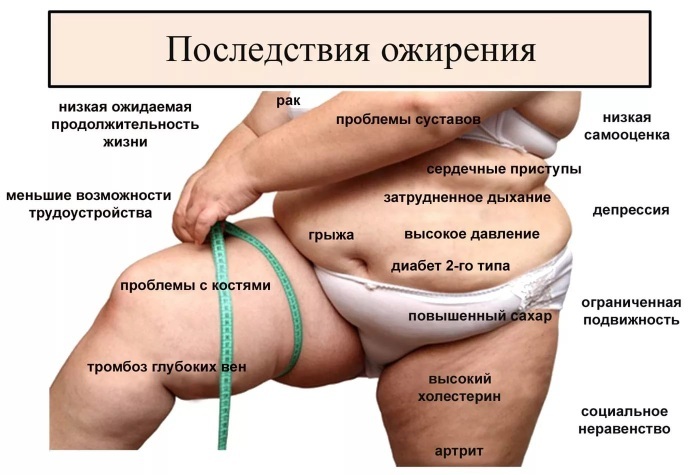
- psycho-emotional stress - under the influence of stress, the nervous system is activated, adrenaline is produced, and the heart rate increases;
- hereditary factor;
- disturbed hormonal background - estrogen maintains normal cholesterol levels, and with menopause in women, the rate decreases, so blood clots may form;
- taking hormonal contraceptives - a group of drugs increases the viscosity of the blood, the likelihood of thrombus formation increases;
- floor - CVDs are more common in men;
- age category - people over 45 are more susceptible to CVD diseases.
Viruses and infections
Pathogens that cause infection or inflammation can invade an important organ such as the heart. If the pathogen is not destroyed in time, CVS diseases develop.
For example, pathologies can appear due to bacteria that live in the mouth or pharynx. Due to damage to the mucous membrane, microorganisms penetrate the bloodstream, and then into the heart tissue. The organ can infect staphylococcus, streptococcus and other bacteria.
Hypodynamia
Physical inactivity is a pathology associated with lack of mobility. The disease negatively affects the heart and blood vessels. In the first case, there is a decrease in the mass of the organ. As a result, the heart works less "economically", contractions become more frequent. Further, the functionality of the organ is disrupted.
That is, the pulse and heart rate increase even at rest. On the electrocardiogram, a deterioration in myocardial nutrition is noted. At the same time, changes occur in the vessels, their elasticity is lost. In severe cases, the development of atherosclerosis (cholesterol deposition) is possible.
Improper nutrition
If a person is not eating properly, it can increase the likelihood of CVD. The food should contain the amount of substances that meets the needs. That is, stocks are excluded so that excess weight is not gained.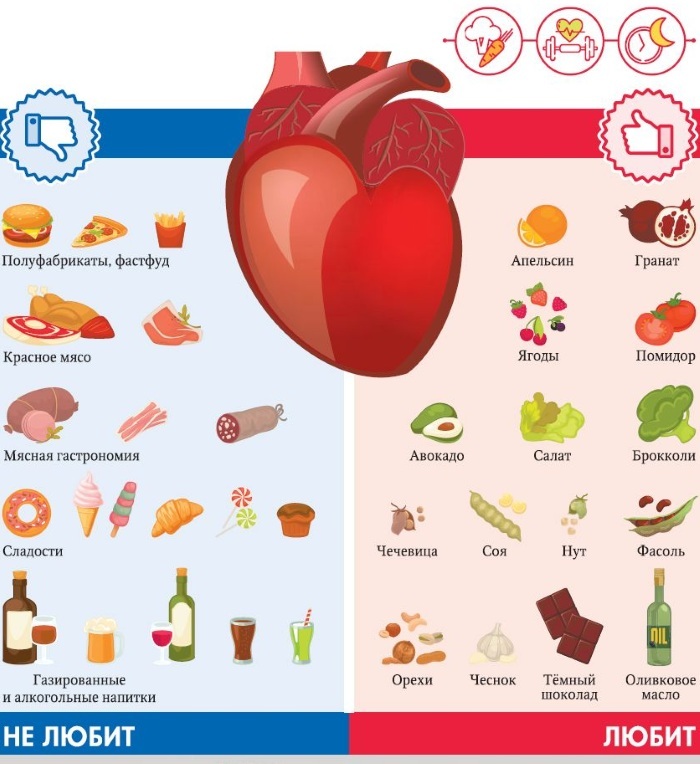
Improper nutrition includes the following points:
- a person eats less than 3 times a day;
- food more than 3 times a day, but in large portions;
- exclusion of clean non-carbonated water;
- fatty, fried, smoked food;
- the diet is dominated by sweet, starchy foods;
- vegetable soups, cereals are excluded from the diet;
- a person buys fatty foods - milk, meat.
Alcohol abuse
Alcohol negatively affects CVS.
Namely:
- blood pressure and pulse change sharply;
- ethanol damages the heart cells - the organ works in an enhanced mode, that is, for wear and tear, as a result, scars can form, the elasticity of the myocardium decreases;
- ethanol destroys the protective membrane of erythrocytes - as a result, blood cells stick together, clots are formed that cannot pass through the vessels, blood clots appear.
The listed negative effect occurs with a one-time consumption of alcohol.
And if a person has an addiction to alcoholic beverages, CVS pathologies can develop:
- arrhythmia;
- atherosclerosis;
- ischemic disease;
- cardiomyopathy.
According to statistics, with the systematic use of alcohol for 2 years, chest pain appears, breathing becomes difficult, and heart rate increases. About 30% of people with alcohol dependence die from the fact that the main organ cannot withstand the load.
Malicious smoking
Nicotine has a negative effect on CVS.
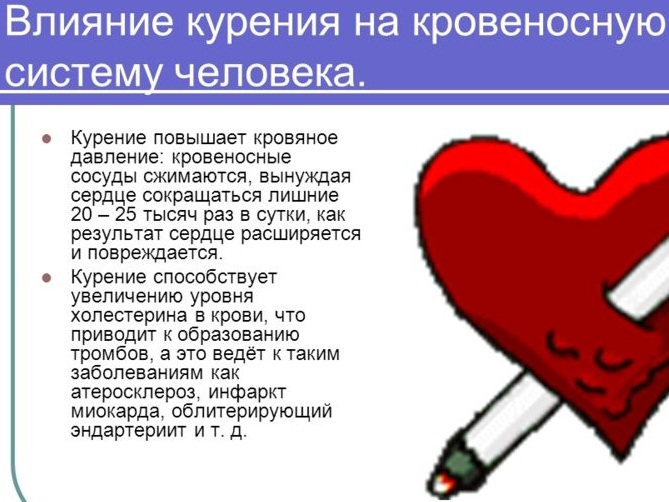
Namely:
- toxic substances that are present in tobacco smoke spread throughout the body in less than 60 seconds;
- if you smoke 2 - 3 cigarettes, small blood vessels spasm for at least 30 minutes;
- if a person smokes constantly, the vessels are almost always in a state of spasm;
- arteries and blood vessels lose their elasticity, that is, they become fragile;
- the lumen of the vessels narrows, an insufficient amount of blood enters the heart;
- when smoking a cigarette, the pulse quickens, that is, the heart works in an enhanced mode;
- Spasm of the coronary vessels is the most serious side effect of cigarettes that can lead to heart attack.
Cigarettes affect the cardiovascular system not only when smoking. For example, a person does not have this habit, but he can inhale smoke. The same disorders appear as during smoking. Therefore, during the examination, cardiologists may ask a question about the presence of people in the family who abuse cigarettes. The phenomenon is called secondhand smoke.
The main symptoms
Cardiovascular diseases (the list of frequently developing pathologies complements the stroke) are characterized by specific symptoms.
| Symptoms | Description |
| Weakness and fatigue | With cardiovascular diseases, a person may feel weak. In addition, there is fatigue with minimal exertion. And also sleep and concentration are disturbed. |
| Headache | With CVD, a symptom can appear for various reasons:
|
| Dyspnea | The symptom is characterized by lack of air, shortness of breath. Shortness of breath is an important symptom that may indicate CVD diseases. With CVD, there are 2 types of symptoms:
|
| Fainting | The blood supply to the brain may deteriorate, resulting in fainting. |
| Irregular heartbeat | The symptom may appear with physical activity or emotional arousal. It seems to a person that the heart will jump out of the chest. |
| Nausea | Some symptoms of CVD diseases are similar to the pathologies of the gastrointestinal tract. For example, nausea and vomiting. This is due to the fact that the lower part of the heart is close to the stomach, so the listed symptoms may appear. |
| Pallor of the skin | With CVS diseases, there is a lack of oxygen. Because of this, the color of the skin may change. |
| Cough | Usually the symptom indicates ARVI. But a cough can appear with cardiovascular diseases. Pathology is judged if the symptom occurs even in the supine position. However, cough medications do not help. |
| Change in blood pressure | Normally, a person's blood pressure (BP) should be up to 130/85 mm Hg. Art. Anyone can have an excess or decrease in the indicator. But if the value deviates from the norm over a long period of time, this indicates pathologies. |
| Pain in the chest | Chest pain is common in people with CVD. Discomfort is of a different nature depending on the specific pathology. |
List of cardiovascular diseases. Typical symptoms, principles of treatment
Cardiovascular diseases make up a large list of pathologies. Each disease has its own symptoms and treatments. Common CVD diseases are listed below.
Ischemia
The full name of the pathology is ischemic heart disease (IHD). With the disease, the blood supply to the myocardium (muscle layer of the organ) is disrupted. Ischemia occurs when the heart is not adequately supplied with oxygen.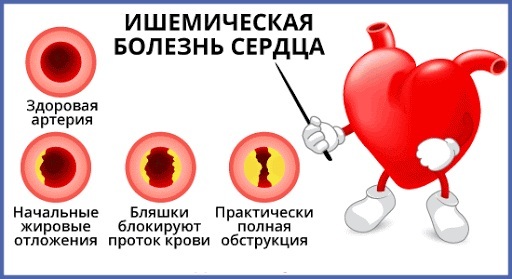
IHD symptoms:
- chest pain that has a constricting and pressing character;
- discomfort increases with physical exertion, and in severe cases - at rest;
- pain can be given to the scapula, neck;
- light-headedness;
- abdominal pain;
- heartburn.
The signs of coronary artery disease are similar for either sex. Differences may lie in the age category. In men, symptoms appear after 55 years, and in women from 65 years.
For the treatment of coronary artery disease, the following groups of drugs are used:
- Antiplatelet agents. The drugs thin the blood and reduce the likelihood of blood clots. Medicines affect the gastrointestinal tract, so they are not recommended for people with ulcers or inflammation. The group includes Cardiomagnyl, Thrombo ASS, Aspirin Cardio.
- Adrenoblockers. The drugs are used to reduce myocardial oxygen consumption. The group includes Atenolol, Bisoprolol, Betalok.
- Statins. Medicines lower blood cholesterol levels. The group includes Atorvastatin, Atoris, Simvastatin.
- Calcium channel blockers. The drugs reduce the heart rate, vascular tone, and the risk of blood clots. The group includes Verapamil, Diltiazem, Nifedipine.
- ACE inhibitors (angiotensin-converting enzyme). Medicines help lower blood pressure. The group includes Enap, Enalapril, Kapoten.
- Nitrates. This group of drugs is almost always prescribed for coronary artery disease to reduce pain in the chest. Medicines affect the tone of blood vessels, after use there may be discomfort in the head, a decrease in blood pressure. Therefore, this group is not recommended for people with impaired blood circulation in the brain, hypotension (blood pressure is less than normal). Medicines include Nitroglycerin, Nitrosprey, Nitromint.
Hypertension
The disease is a repeated excess of blood pressure above normal. The diagnosis of hypertension is made in the case of high blood pressure (more than 140/90 mm Hg), but if the indicator is registered with 3 measurements. Moreover, pressure control is carried out at different times, in a calm atmosphere.
Symptoms of essential hypertension:
- dizziness;
- throbbing in the head;
- increased sweat separation;
- redness of the skin of the face;
- the appearance of flies before the eyes;
- anxiety;
- increased irritability;
- chills;
- discharge of vomit;
- poor memory;
- reduced performance;
- swelling of the eyelids after sleep;
- face enlargement after sleep;
- swelling of the fingers.

Treatment of arterial hypertension includes the use of the following drugs:
- Adrenoblockers.
- Calcium channel blockers.
- Sartans.
- Diuretics The drugs remove excess fluid from the body and reduce swelling. The group includes Veroshpiron, Diuver, Hydrochlorothiazide.
Hypertension can lead to a hypertensive crisis. The condition consists in an increase in blood pressure to a critical level (usually the indicator increases by 40-60 mm Hg. Art. from the optimal individual value for each person). A hypertensive crisis is dangerous not by an increase in blood pressure, but by the likelihood of complications (blindness, stroke, kidney failure).
Symptoms:
- sharp pain in the back of the head;
- change in gait;
- vomiting - the symptom does not disappear when using the funds from the home first aid kit.
When symptoms of a hypertensive crisis appear, an ambulance team must be called.
Before arrival, you should perform a number of actions:
- Place the person on a bed or couch.
- To provide blood flow to the brain, for this you need to bend your knees.
- It is desirable that the head is above the body - for this, you can put a pillow.
- Provide fresh air by opening a window.
Rheumatic heart disease
A connective tissue disease in which the lesion is localized in the heart. Pathology is a complication of infectious processes. For example, rheumatic heart disease appears after untreated sore throat. The disease is characterized by damage to all walls of the heart.
Usually, symptoms of rheumatic heart disease appear 1 to 3 weeks after treatment of an infectious pathology.
Common signs:
- high body temperature;
- lack of appetite;
- joint pain;
- increased sweating;
- discharge of blood from the nasal cavity;
- cough after physical activity;
- weak chest pain;
- swelling in the legs;
- enlargement of the liver.
For the treatment of rheumatic heart disease, the following groups of drugs are used:
- Glucocorticosteroids. Medicines of this group have anti-inflammatory, anti-allergic, anti-shock effects. Additionally, glucocorticosteroids strengthen the immune defense. And also drugs inhibit connective tissue reactions during inflammation and reduce the likelihood of scarring. The group includes Prednisolone, Dexamethasone.
- Non-steroidal anti-inflammatory drugs (NSAIDs). Drugs in this group eliminate pain, reduce temperature. NSAIDs include Nurofen, Ibuprofen, Dexalgin.
- Antibacterial. Medicines destroy pathogenic microorganisms. Antibiotics are designed to combat infectious complications. The group includes Ampicillin, Amoxiclav, Klacid.
- Diuretics
Additionally, it is possible to use drugs that eliminate symptoms associated with cardiac activity (adrenergic blockers, calcium channel blockers, and others).
Cardiomyopathy
Cardiovascular diseases, the list of which also includes often diagnosed cardiomyopathy, can change the size of the muscle layer of the main organ. As a result, the heart pumps blood inadequately and contracts. This disorder is called cardiomyopathy.
Symptoms of the disease:
- swelling in the legs;
- cough for no reason;
- blue fingers on the hands;
- chest pain;
- fainting;
- increased sweating;
- reduced performance.
Additional symptoms depend on the type of disease.
Treatment of pathology includes the use of the following medications:
- Nitrates.
- Adrenoblockers.
- Antiplatelet agents.
- Calcium channel antagonists.
- ACE inhibitors.
- Diuretics
Arrhythmia
The disease involves an unstable heart rate and rhythm.
The type of arrhythmia includes:
- tachycardia - increased heart rate;
- bradycardia - slow heartbeat;
- extrasystole - premature contractions of the heart;
- atrial fibrillation - chaotic contractions of the atrial muscles.
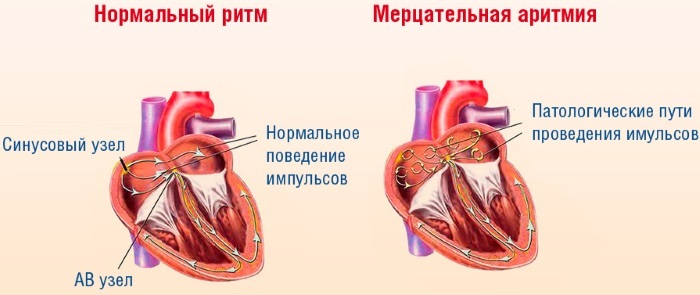
Arrhythmia symptoms:
- interruptions in the activity of the heart;
- cold extremities;
- feeling of heat;
- dizziness;
- muscle weakness;
- excessive sweating.
If the case is severe, there is additionally pain in the heart, pallor of the skin. And also blood pressure changes, the person is in a light-headed state.
For the treatment of arrhythmias, the following groups of drugs are used:
- Cardiac glycosides. The drugs restore the rhythm of the main organ. The group includes Digoxin, Korglikon.
- Anticoagulants. Medicines can thin the blood and prevent thrombosis. The group includes Warfarin, Sinkumar, Dikumarin. But instead of this group, antiplatelet agents can be used, since they have a reduced likelihood of side effects.
- Adrenoblockers.
- Calcium channel blockers.
- Replenishing potassium and magnesium deficiency. The group includes Panangin, Asparkam.
A pacemaker may be installed as a surgical treatment. It is used only for severe disease. The device emits a strong impulse, due to which the likelihood of recurrent arrhythmias is reduced.
Atherosclerosis
Atherosclerosis is a disease in which the blood vessels are affected by deposits of cholesterol. As a result, stroke and ischemia may develop.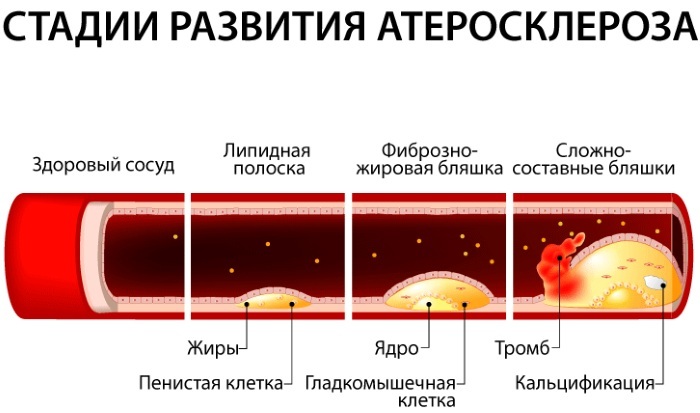
Symptoms of atherosclerosis:
- memory impairment;
- a sharp change in mood;
- irritability;
- pain in the head that does not improve with pain relievers;
- chest pain of a pressing or burning character - unlike angina pectoris, this discomfort does not go away for a long time, discomfort may increase or decrease;
- discomfort can be given to the upper limb, neck, back.
The following drugs are used for treatment:
- Statins.
- Fibrates. The drugs interfere with the production of large amounts of fat in the body. The group includes Clofibrate, Ciprofibrate.
Additionally, they can use a drug treatment plan similar to arrhythmia. In addition to drugs, surgery is performed for atherosclerosis. Intervention is performed if medications do not help, the disease is advanced.
The following methods can be used as an operation:
- Coronary angioplasty. The procedure is necessary to open a blocked or narrowed artery. As a result, chest pain decreases and blood supply to the heart improves. Sometimes a stent (mesh tube) is left in the vessel to keep the artery open at all times.
- Bypass surgery. With the help of arteries and veins from other parts of the body, the doctor blazes a new path. This is necessary to bypass the constricted vessel and restore blood circulation.
Cardiosclerosis
With myocardial disease, scarring occurs inside the organ. Cardiosclerosis most often develops in the absence of therapy for other pathologies (coronary artery disease, atherosclerosis).
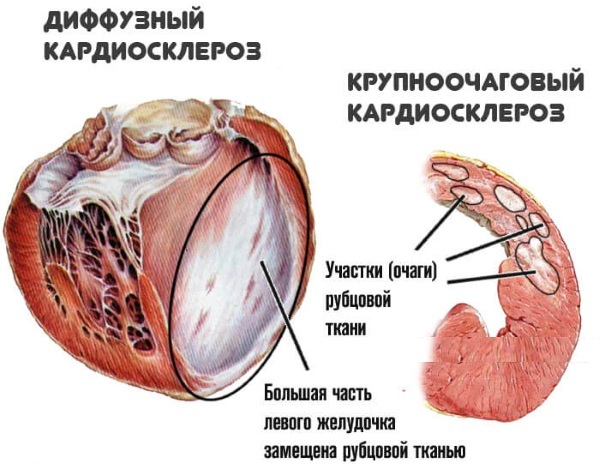
Symptoms:
- pain in the region of the heart;
- an increase in the myocardium.
The following medicines are used for treatment:
- Cardiac glycosides.
- Calcium channel blockers.
- Antiplatelet agents.
- Nootropic. The drugs improve blood circulation in the brain. The group includes Cavinton, Bilobil, Glycine.
- Diuretics
Surgery can be used to treat cardiosclerosis.
There are 2 methods of operation:
- Organ transplant. With a complete replacement of the heart, you can eliminate all symptoms and provide the body with oxygen. But such an operation is used only in severe cases. If the disease is mild, the transplant is associated with unnecessary risk.
- Bypass surgery.
- Installing a pacemaker.
Myocardial infarction
Pathology is the death of the muscles of the heart, which develops as a result of acute circulatory disorders. The table provides a detailed description of the symptoms and treatments.
| Name | Description |
| Symptoms | A heart attack is characterized by the following symptoms:
|
| First aid | If there is a suspicion of myocardial infarction, you need to call an ambulance. Before the arrival of doctors, the plan should be fulfilled: 1. Put the person on the bed. 2. Raise your head above your body. 3. Provide fresh air. 4. Exclude physical activity, smoking, eating. 5. Give a drug belonging to the nitrate group. It is necessary to check with the dispatcher in advance if a person can take medications before the arrival of the brigade. Most often, this is not recommended, since the picture of the disease may change. |
| Drug treatment | For the treatment of a heart attack, the following groups of drugs are used:
|
| Surgical operations | The doctor can perform emergency surgery. As an intervention, shunting or angioplasty is used. |
Stroke
Cardiovascular diseases, which list more than 50 pathologies, are often associated with stroke. Pathology is characterized by impaired blood circulation in the brain, as a result, a large lesion develops.
Stroke symptoms:
- sudden weakness;
- numbness of the muscles of the face and limbs;
- impaired speech;
- dizziness;
- violation of coordination of movements;
- change in gait;
- the location of the corners of the lips on different lines (with a smile);
- weak handshake;
- when raising the upper limbs, one of them spontaneously descends.

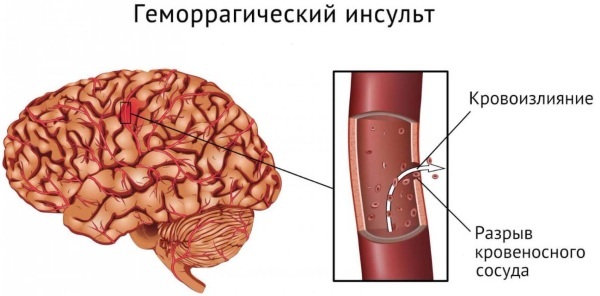
Hemorrhagic stroke
There are several types of strokes:
- Ischemic. In another way, it is called a brain stroke. Pathology is common.
- Hemorrhagic (hematoma inside the brain) - the condition is less common (10%). It develops due to damage to a blood vessel.
If you suspect a stroke, you need to call an ambulance.
Pathology therapy consists of 3 stages:
- Urgent care.
- Inpatient treatment. In ischemic stroke, tissue plasminogen activator is administered as the main drug. The group is able to dissolve blood clots. The medication can be administered no later than 3 hours after the onset of the stroke. The drugs have a large number of contraindications, so the doctor takes into account the benefits of use and harm to health. Thrombolytics include Purolaza, Gemaza, Aktilize. Additionally, antiplatelet agents or anticoagulants are administered.
If the stroke is hemorrhagic, antihypertensive drugs are recommended (Enap, Captopril, Enalapril).
- Rehabilitation at home. Massage therapy, physiotherapy exercises are prescribed. Additionally, it is recommended to take pain relievers, nootropic drugs. They can also prescribe sedatives that normalize the emotional background - Novo-Passit, Afobazol. In serious cases, antidepressants are required to eliminate depression - Adaptol, Gidazepam.
If the hematoma is large, the person has fallen into a coma, they can perform an operation. The variety is determined by the doctor individually.
Pulmonary embolism
This condition threatens human life. It consists in blockage of the pulmonary artery or its branches with an embolus (a piece of a blood clot). The abbreviated name is TELA. This condition is not an independent disease; it occurs as a complication of venous thrombosis (most often of the lower extremities).
Pulmonary embolism symptoms:
- discomfort in the chest - the sign increases its intensity with a deep breath;
- cough, which may contain blood sputum - a symptom occurs if a hemorrhage has entered the lung;
- decrease in blood pressure - if the case is severe, the indicator may be below 90 mm Hg. Art .;
- change in heart rate;
- perspiration that is cold and sticky;
- grayish or bluish skin tone;
- high temperature - the indicator can reach up to 38 degrees;
- loss of consciousness.
If the case is mild, there may be no signs of PE. Fever, cough, mild shortness of breath are allowed. PE symptoms can be similar to heart attack or pneumonia.
If the condition is not identified, chronic thromboembolic pulmonary hypertension (increased pressure in the pulmonary artery) develops. Symptoms include shortness of breath, which occurs during physical activity.
The condition requires urgent medical attention. If this point is neglected, death may occur.
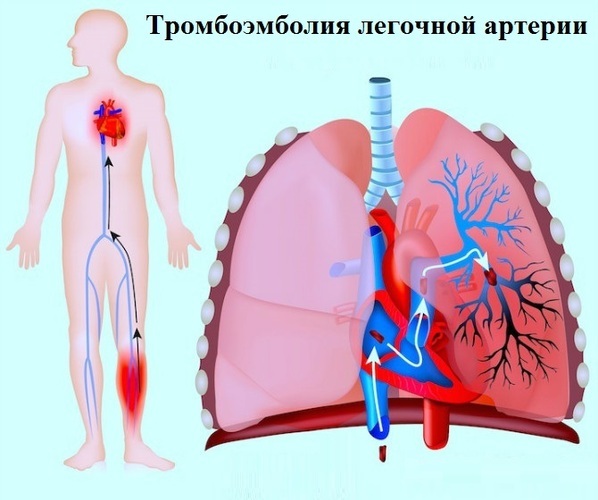
For the treatment of PE, anticoagulants and thrombolytics are prescribed. But they can perform a surgical operation. For example, angioplasty.
Heart failure
In this condition, blood circulation in the CVS is impaired. The disease develops due to insufficient contraction of the heart, which occurs suddenly or exists for a long time.
The type of pathology is indicated in the table:
| Heart failure name | Description |
| Sharp | The reasons for the appearance include severe forms of arrhythmia, heart attack. Symptoms are more pronounced in acute illness. Signs of right ventricular failure:
|
| Chronic | Develops gradually and slowly. Symptoms:
|
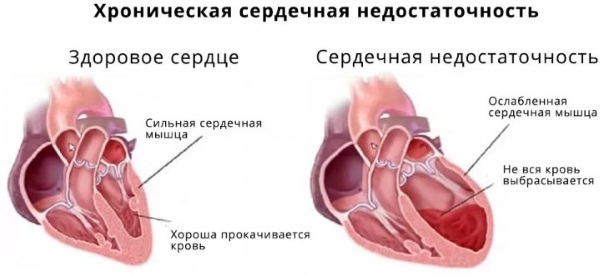
Medication for heart failure:
- cardiac glycosides;
- ACE inhibitors;
- nitrates;
- diuretics;
- anticoagulants;
- adrenergic blockers.
Heart disease
This group of diseases is characterized by a violation of the anatomical structure of the heart valves or septa. Defects can be congenital or appear during life under the influence of certain factors (acute fever, atherosclerosis, trauma).
Symptoms:
- murmurs when examining the heart;
- fainting;
- cyanosis of the skin;
- swelling of the lower extremities;
- accumulation of fluid in the abdominal cavity;
- change in blood pressure.
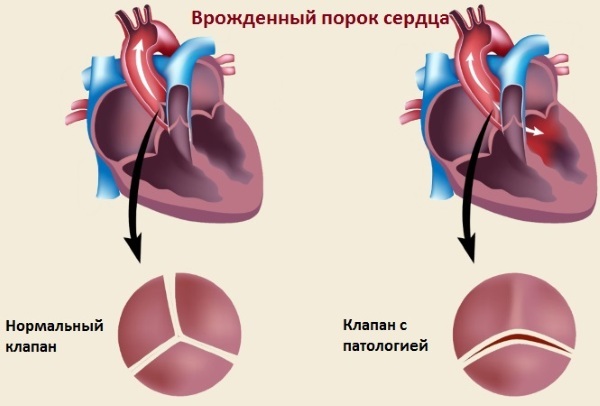
Drug treatment:
- anticoagulants;
- diuretics;
- adrenergic blockers;
- ACE inhibitors;
- cardiac glycosides.
Infective endocarditis
The disease is characterized by damage to the inner lining of the heart (endocardium).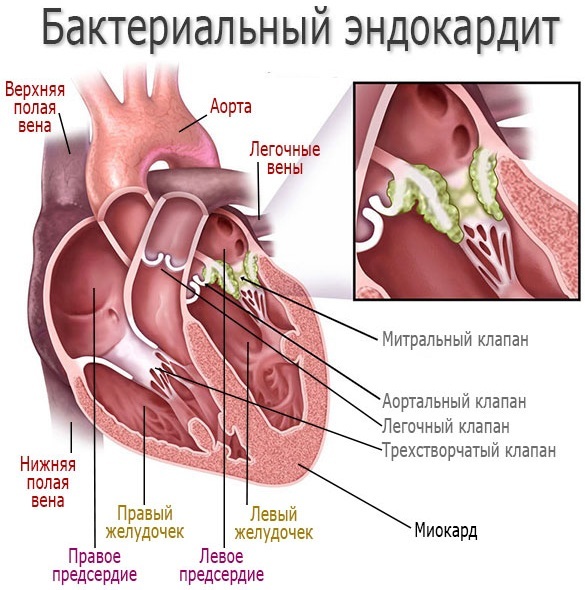
Symptoms:
- lack of appetite;
- decrease in body weight;
- changes in body temperature;
- increased sweating;
- small punctate hemorrhages under the skin;
- change in the color of the skin - it becomes pale gray or yellowish green.
Medical treatment includes the use of antibacterial agents.
Diagnostic methods
If you suspect cardiovascular disease, an examination is performed. Based on the results, you can make an accurate diagnosis and prescribe treatment.
The following procedures are used as a survey:
- Delivery of a general analysis of blood and urine. According to the results, it is possible to determine indicators important for the body (erythrocytes, hemoglobin).
- Lipid profile. Expanded study of lipid and cholesterol metabolism. The results can be used to assess the risk of developing atherosclerosis.
- Electrocardiogram (ECG). The procedure detects a violation of the frequency and rhythm of the heartbeat. In an ECG, sensors are attached to a person's skin. The device registers the work of the heart, the result is recorded on paper. An electrocardiogram is prescribed for chest pain, arrhythmias, shortness of breath.
- Echocardiography (EchoCG). For carrying out, an apparatus that emits ultrasound is used. The sensor is lubricated with a gel for better visualization, and is guided over the skin. Waves propagate in tissues, changing the frequency, period and amplitude of oscillations depending on the state of the heart. The waves return to the sensor in a modified form and are converted into an electrical signal. The machine displays the image on the monitor. EchoCG is prescribed for noise during listening, myocardial infarction, predisposition to CVS diseases. And also the procedure can be recommended for other cardiac pathologies.
- 24-hour blood pressure monitoring (ABPM). The indicator is recorded for 24 hours. ABPM allows you to accurately determine hypertension or hypotension. If the indicator is changed only once, the information is incomplete. For example, some people are worried when monitoring their blood pressure in a hospital. With ABPM, a device is hung on the human body, and the cuff is placed on the arm. After a certain period of time (usually 30 - 60 minutes), the pressure is measured each time. Of the minuses, the complexity of night sleep can be noted, since the indicator is monitored. Additionally, you may need to record all the actions and symptoms of a person throughout the day.
-
DailyHolter monitoring. The apparatus is hung on the human body, and the electrodes are attached to the skin. All activities of the heart are recorded. Then the device is connected to a computer, the cardiologist decrypts the information received.

Ischemic heart disease is diagnosed by Holter monitoring - Treadmill test. Load survey performed on the track. During the test, electrodes are glued to the skin of a person. The track changes the travel speed and the level of rise. The examination helps to identify ischemia. And also the treadmill test is prescribed for people after myocardial infarction, vascular surgery.
- Myocardial scintigraphy. A drug is injected into the human body, the substances of which accumulate in the heart. But this only happens in places with a good blood supply. Radiation radiation is detected using an apparatus.
- Computer (CT) or magnetic resonance (MRI) tomography. The results provide high quality images in different projections.
What can be done for the health of the heart and blood vessels?
There are rules, observing which you can keep the health of the CVS.
These include the following items:
- Healthy food;
- add physical activity - you do not need to load the body too much, morning exercises, walking, swimming are enough;
- for the prevention of CVD, donate blood once every 6 months. - the item includes general analysis, lipid profile;
- control body weight and reduce weight in case of excess of the norm;
- to refuse from bad habits;
- have a good rest - sleep should last at least 8 hours a day, and you also need to take breaks at work;
- control blood pressure 1 - 2 times a day;
- undergo a routine examination by a cardiologist once every 6 months.
Pathologies of the heart and blood vessels are common throughout the world. There are many reasons why CVD can appear (unhealthy diet, lack of physical activity, etc.).
The list of diseases of the cardiovascular system is large. Each pathology has distinctive symptoms and treatment options. To reduce the likelihood of complications, it is necessary to consult a doctor in a timely manner for diagnosis.
Video about cardiovascular diseases
Symptoms and prevention of cardiovascular diseases:

